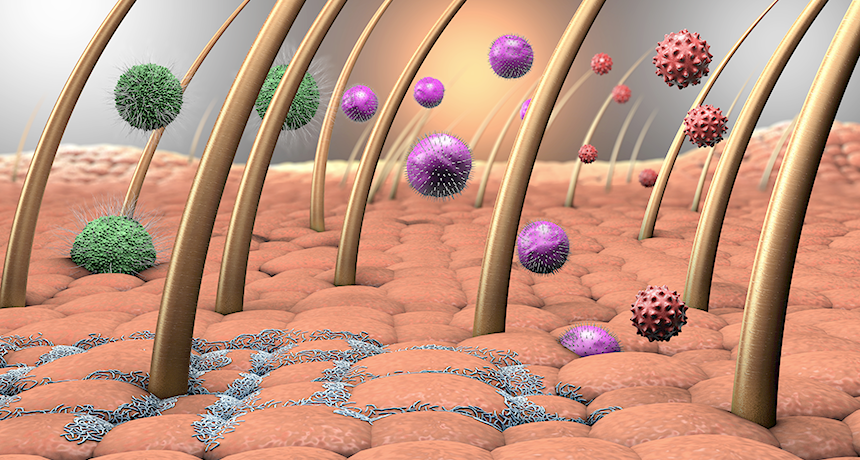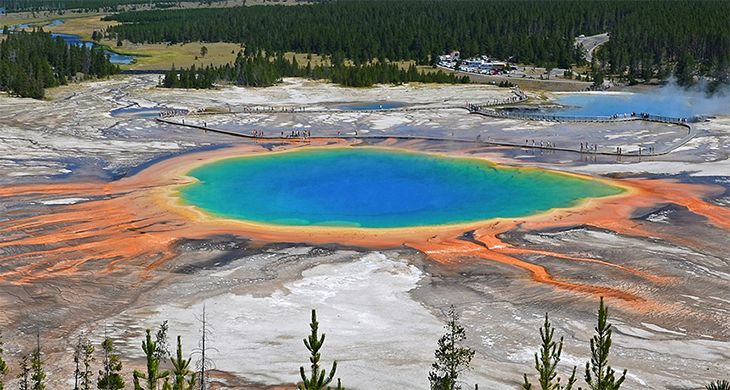Sweat-slurping ‘aliens’ live on your skin
Kids and the elderly seem to host more of these archaea than do teens and adults

Among the microbes found on people’s skin (artist’s illustration) are single-celled organisms called archaea.
man_at_mouse/iStockphoto
Single-celled lifeforms called archaea (Ar-KEE-uh) thrive inside boiling hot springs and frigid Antarctic lakes. As such, these microbes picked up a reputation for preferring extreme environments. New data now show that’s far from true. Researchers are finding them everywhere — even on skin. And the latest study shows that children and the elderly people host more of these unique tagalongs than do teens and adults.
Archaea are about the size and shape of bacteria. In fact, scientists for a long time confused them with bacteria. But in the 1970s, biologists realized these microbes had different types of cell walls. And their genes, which instruct those cells on what to do, also were very different. Scientists decided archaea must constitute a whole new form of life. It was almost like aliens had been discovered here on Earth.
Some of these weird microbes “like [to eat] our sweat,” reports study author Hoi-Ying Holman. She’s a scientist at Lawrence Berkeley National Laboratory in California. There, she uses a powerful microscope to look at cells or tiny life forms. Holman joined an international team of scientists for the new study. Her team hadn’t set out to study skin. They had been trying to stop archaea from hitchhiking on spacecraft bound for Mars.
Story continues below image

NASA and the European Space Agency had asked their group to search spacecraft for archaeal hitchhikers. These space agencies want to keep their ships clean. Ferrying even microbial Earthlings to another planet might risk harm to any Martian life (should it exist). The agencies knew bacteria weren’t likely to survive a trip through space. But as renowned extremophiles (Ex-TREEM-oh-files), archaea just might.
And archaea were lurking on spacecraft, she found. They turned up in rooms at labs and hospitals that were supposed to be sterile — as in germfree. “The most likely source was human skin,” Holman notes. So her group did a small study. It checked 13 volunteers for the germs. And all hosted archaea on their skin.
For their new study, the researchers examined samples from another 51 people, all in Germany. Again, all had archaea, but amounts varied. Those under age 12 had five to eight times more archaea on their skin than did teens and adults. So did people over age 60. In any age group, people with dry skin hosted more.
Overall, the differences “surprised me,” says Holman. Her team described its findings online June 22 in Scientific Reports.
Tiny teddy bears
Researchers don’t yet know why age matters when it comes to archaea. One possible explanation is that the skin changes during puberty. That’s when many teens get zits. Those changes also may make the skin less inviting for archaea. And the relationship might work the other way, too — having more archaea might help keep skin healthy.
One group of archaea, among the most abundant on Earth, are Thaumarchaeota (Thau-mar-kee-OH-ta). And they seem to enjoy slurping human sweat. As such, these bugs may even reduce body odor.
When Holman’s teenage son heard about this, he joked that maybe he should apply some to his face to prevent acne. “Don’t do anything of the sort!” Holman told him. Biologists simply don’t know enough about the species of these found on skin. Their studies have yet to find any of them that appear dangerous. Still, archaea are so poorly known that it’s certainly possible some might play a role in disease.
Ecologist Rob Dunn, who was not involved in the study, is not too concerned. At North Carolina State University in Raleigh, he studies many species, from ants to microbes. Five years ago, he turned up archaea in human belly buttons. To him, “they’re like the teddy bears of the single-celled world.”
The new study is just “the beginning of the story,” Dunn says. He’s excited that researchers are finally taking notice of these microbes. In the past, scientists hadn’t seen archaea on people for a very simple reason: They weren’t looking. They’d go to hot springs or frozen lakes to search for them. As it turns out, they needn’t have looked farther than their own bodies.
Says Dunn, there’s a lesson in all this: “It’s still possible to discover totally new things without leaving the house.”








